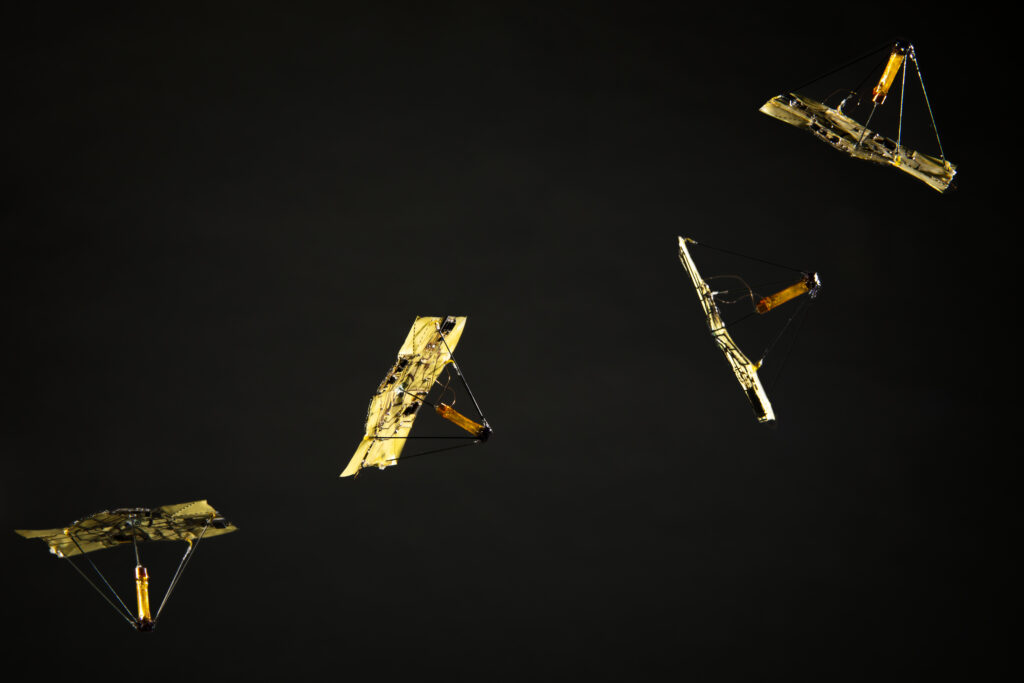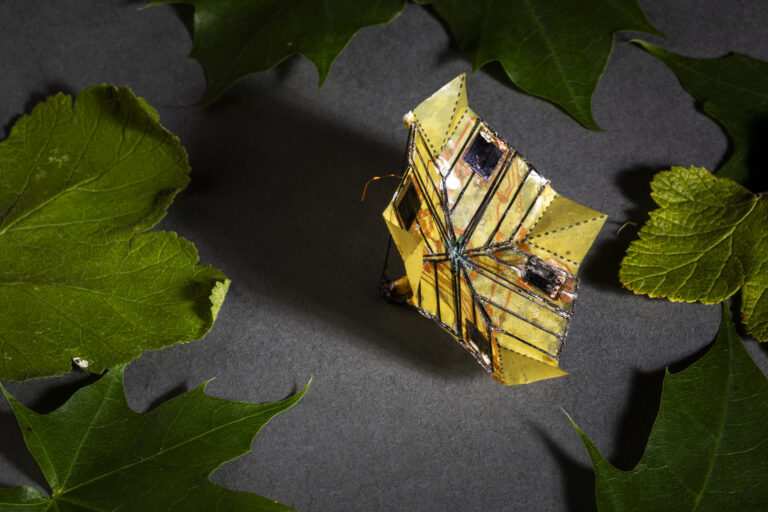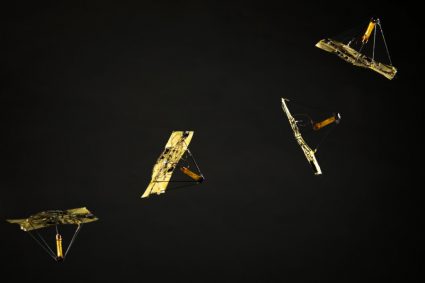Battery-free origami microfliers from UW researchers offer a new bio-inspired future of flying machines

Researchers at the University of Washington developed small robotic devices that can change how they move through the air by “snapping” into a folded position during their descent. Shown here is a timelapse photo of the “microflier” falling in its unfolded state, which makes it tumble chaotically and spread outward in the wind. Photo by Mark Stone/University of Washington
By Roger Van Scyoc
On a cool afternoon at the heart of the University of Washington’s campus, autumn, for a few fleeting moments, appears to have arrived early. Tiny golden squares resembling leaves flutter then fall, switching from a frenzied tumble to a graceful descent with a snap.
Aptly named “microfliers” and inspired by Miura-fold origami, these small robotic devices can fold closed during their descent after being dropped from a drone. This “snapping” action changes the way they disperse and may, in the future, help change the way scientists study agriculture, meteorology, climate change and more.
“In nature, you see leaves and seeds disperse in just one manner,” said Kyle Johnson, an Allen School Ph.D. student and a first co-author of the paper on the subject published in Science Robotics. “What we were able to achieve was a structure that can actually act in two different ways.”
When open flat, the devices tumble chaotically, mimicking the descent of an elm leaf. When folded closed, they drop in a more stable manner, mirroring how a maple leaf falls from a branch. Through a number of methods — onboard pressure sensor, timer or a Bluetooth signal — the researchers can control when the devices transition from open to closed, and in doing so, manipulate how far they disperse through the air.
How could they achieve this? By reading between the lines.
“The Miura-ori origami fold, inspired by geometric patterns found in leaves, enables the creation of structures that can ‘snap’ between a flat and more folded state,” said co-senior author Vikram Iyer, an Allen School professor and co-director of the Computing for the Environment (CS4Env) initiative. “Because it only takes energy to switch between the states, we began exploring this as an energy efficient way to change surface area in mid-air, with the intuition that opening or closing a parachute will change how fast an object falls.”
That energy efficiency is key to being able to operate without batteries and scale down the fliers’ size and weight. Fitted with a battery-free actuator and a solar power-harvesting circuit, microfliers boast energy-saving features not seen in larger and heavier battery-powered counterparts such as drones. Yet they are robust enough to carry sensors for a number of metrics, including temperature, pressure, humidity and altitude. Beyond measuring atmospheric conditions, the researchers say a network of these devices could help paint a picture of crop growth on farmland or detect gas leaks near population centers.
“This approach opens up a new design space for microfliers by using origami,” said Shyam Gollakota, the Thomas J. Cable Endowed Professor in the Allen School and director of the school’s Mobile Intelligence Lab who was also a co-senior author. “We hope this work is the first step towards a future vision for creating a new class of fliers and flight modalities.”
Weighing less than half a gram, microfliers require less material and cost less than drones. They also offer the ability to go where it’s too dangerous for a human to set foot.
For instance, Johnson said, microfliers could be deployed when tracking forest fires. Currently, firefighting teams sometimes rappel down to where a fire is spreading. Microfliers could assist in mapping where a fire may be heading and where best to drop a payload of water. Furthermore, the team is working on making more components of the device biodegradable in the case that they can’t be recovered after being released.
“There’s a good amount of work toward making these circuits more sustainable,” said Vicente Arroyos, another Allen School Ph.D. student and first co-author on the paper. “We can leverage our work on biodegradable materials to make these more sustainable.”
Besides improving sustainability, the researchers also tackled challenges relating to the structure of the device itself. Early prototypes lacked the carbon fiber roots that provide the rigidity needed to prevent accidental transitions between states.

The research team took inspiration from elm and maple leaves in designing the microfliers. When open flat, the devices tumble chaotically, similar to how an elm leaf falls from a branch. When they are “snapped” into a folded position, as shown here, they descend in a more stable, straight downward manner like a maple leaf. Photo by Mark Stone/University of Washington
Collecting maple and elm leaves from outside their lab, the researchers noticed that while their origami structures exhibited the bistability required to change between states, they flexed too easily and didn’t have the venation seen in the found foliage. To gain more fine-grained control, they took another cue from the environment.
“We looked again to nature to make the faces of the origami flat and rigid, adding a vein-like pattern to the structure using carbon fiber,” Johnson said. “After that modification, we no longer saw a lot of the energy that we input dissipate over the origami’s faces.”
In total, the researchers estimate that the development of their design took about two years. There’s still room to grow, they added, noting that the current microfliers can only transition from open to closed. They said newer designs, by offering the ability to switch back and forth between states, may offer more precision and flexibility in where and how they’re used.
During testing, when dropped from an altitude of 40 meters, for instance, the microfliers could disperse up to distances of 98 meters in a light breeze. Further refinements could increase the area of coverage, allowing them to follow more precise trajectories by accounting for variables such as wind and inclement conditions.
Related to their previous work with dandelion-inspired sensors, the origami microfliers build upon the researchers’ larger goal of creating the internet of bio-inspired things. Whereas the dandelion-inspired devices featured passive flight, reflecting the manner in which dandelion seeds disperse through the wind, the origami microfliers function as complete robotic systems that include actuation to change their shape, active and bi-directional wireless transmission via an onboard radio, and onboard computing and sensing to autonomously trigger shape changes upon reaching a target altitude.
“This design can also accommodate additional sensors and payload due to its size and power harvesting capabilities,” Arroyos said. “It’s exciting to think about the untapped potential for these devices.”
The future, in other words, is quickly taking shape.
“Origami is inspired by nature,” Johnson added, smiling. “These patterns are all around us. We just have to look in the right place.”
The project was an interdisciplinary work by an all-UW team. The paper’s co-authors also included Amélie Ferran, a Ph.D. student in the mechanical engineering department, as well as Raul Villanueva, Dennis Yin and Tilboon Elberier, who contributed as undergraduate students studying electrical and computer engineering, and mechanical engineering professors Alberto Aliseda and Sawyer Fuller.
Johnson and Arroyos, who co-founded and currently lead the educational nonprofit AVELA – A Vision for Engineering Literacy & Access, and their teammates have done outreach efforts in Washington state K-12 schools related to the research, including showing students how to create their own bi-stable leaf-out origami structure using a piece of paper. Check out a related demonstration video here, and learn more about the microflier project here and in a related UW News release and GeekWire story.

The Paul G. Allen School of Computer Science & Engineering
is part of the University of Washington.
Credit: Source link


Comments are closed.